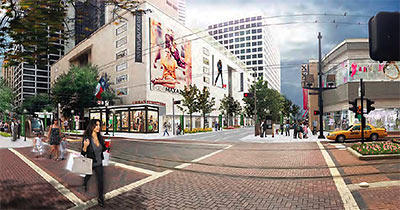
That retail task force that Mayor Parker put together about the same time that Macy’s announced it was closing the Downtown store came through with its first report yesterday, recommending that Dallas St. between Milam and La Branch — or between the hotels on the west side of Downtown and the hotels, Discovery Green, and George R. Brown Convention Center on the east — be prettied up into a kind of retail promenade. And the task force recommends that it happen sooner rather than later, in time to capitalize on the disposable incomes of the hordes coming to town for the NCAA Final Four in 2016 and the Super Bowl in 2017.
The rendering above, included in the report, shows a Kardashian body double strolling through the intersection of Main St. and Dallas; the Sakowitz building, catty-corner across from the to-be-demolished-in-a-week Macy’s, would pair with GreenStreet to anchor the linear district and provide similar photo opportunities. It appears that the task force hopes to lure national retailers and rally existing tenants and landowers, like Hilcorp, to the cause with tax breaks and other incentives, including waiving the city ordinance requiring that signage Downtown be no taller than 42.5 ft.


 “. . . I’ve talked a lot about the bad way some developers approach growth in Houston. But neighborhoods are addressing it wrong, too. They’re too reactionary. They sit around doing nothing until a developer proposes something they don’t like, then they mobilize to try to kill it. They need to ask themselves ‘what do we really want in and around our neighborhood,’ and then create master plans to communicate it. (The master plans wouldn’t be enforced — that would be zoning — but they could be used by developers to get a sense of what the neighbors would oppose.)
The Super Neighborhoods were supposed to be a venue where this could happen — they were originally under the auspices of the Houston Planning Department. But I’ve found that it’s actually the Management Districts that are doing master plans. It’s great that they’re happening, but Management Districts are paid for by and primarily serve businesses; and single family neighborhoods aren’t even trying to get in on the efforts.” [
“. . . I’ve talked a lot about the bad way some developers approach growth in Houston. But neighborhoods are addressing it wrong, too. They’re too reactionary. They sit around doing nothing until a developer proposes something they don’t like, then they mobilize to try to kill it. They need to ask themselves ‘what do we really want in and around our neighborhood,’ and then create master plans to communicate it. (The master plans wouldn’t be enforced — that would be zoning — but they could be used by developers to get a sense of what the neighbors would oppose.)
The Super Neighborhoods were supposed to be a venue where this could happen — they were originally under the auspices of the Houston Planning Department. But I’ve found that it’s actually the Management Districts that are doing master plans. It’s great that they’re happening, but Management Districts are paid for by and primarily serve businesses; and single family neighborhoods aren’t even trying to get in on the efforts.” [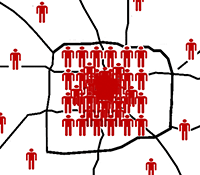 “More density is coming to the Heights and every other Inner Loop neighborhood, because the economic factors at work are unstoppable. Barring a disaster wrecking Houston (natural or otherwise) or an economic crash, more people are coming, and lots of them will want to live near the central parts of the city. All we’re debating is how that will happen. Will needed infrastructure improvements happen? Will there be better transit? Will the density be added in a way to preserves the original neighborhood, and what does that look like?
I have no problem with this kind of development along Yale or Studewood. I think an ideal outcome is main streets with good transit access and dense housing, retail, etc. with historically significant neighborhoods preserved nearby. I think what Arlington County, VA has done along these lines stands as an excellent example.
And the idea that renters bring a neighborhood down is just stupid. unless your idea of a dynamic Heights is one where the average age is 50.” [
“More density is coming to the Heights and every other Inner Loop neighborhood, because the economic factors at work are unstoppable. Barring a disaster wrecking Houston (natural or otherwise) or an economic crash, more people are coming, and lots of them will want to live near the central parts of the city. All we’re debating is how that will happen. Will needed infrastructure improvements happen? Will there be better transit? Will the density be added in a way to preserves the original neighborhood, and what does that look like?
I have no problem with this kind of development along Yale or Studewood. I think an ideal outcome is main streets with good transit access and dense housing, retail, etc. with historically significant neighborhoods preserved nearby. I think what Arlington County, VA has done along these lines stands as an excellent example.
And the idea that renters bring a neighborhood down is just stupid. unless your idea of a dynamic Heights is one where the average age is 50.” [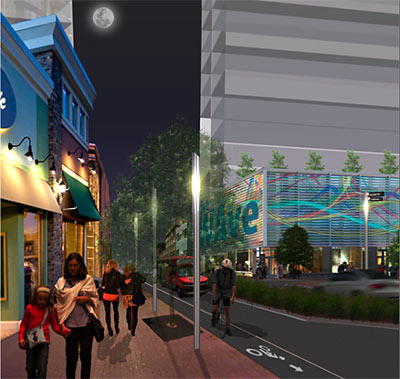
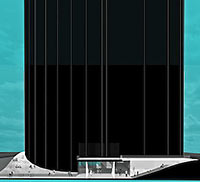 Why isn’t there more street life Downtown? A recent architectural exhibition suggests that one cause might be the sealed world of aÂ
Why isn’t there more street life Downtown? A recent architectural exhibition suggests that one cause might be the sealed world of a 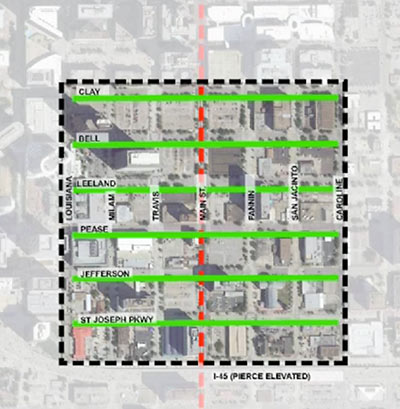
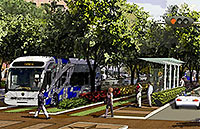 Why not both? Yesterday, Mayor Parker announced a $556 million plan that, if approved by city council on April 24, wouldÂ
Why not both? Yesterday, Mayor Parker announced a $556 million plan that, if approved by city council on April 24, would 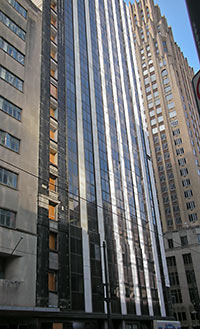 Houston Politics’ Mike Morris is reporting that city council will vote today to decide whether it will loan Pearl Real Estate up to $7.4 million toward the $81 million renovation and redevelopment of the 22-story
Houston Politics’ Mike Morris is reporting that city council will vote today to decide whether it will loan Pearl Real Estate up to $7.4 million toward the $81 million renovation and redevelopment of the 22-story